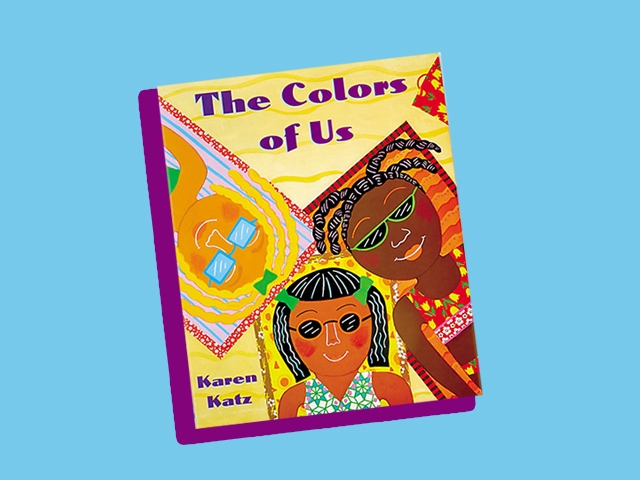In this revolutionary moment — in the wake of the recent murders of Breonna Taylor, Tony McDade, George Floyd and countless others — we, as Jews, are moved to reflect upon how we can advocate for racial justice. While many of us have been protesting and donating to community organizations, we also know that working for social justice can start at home.
At Kveller, we’re aiming to help center these conversations, taking the lead from Black Jewish parents and sharing stories about how to raise anti-racist kids, as well as providing a relevant reading list. Though I am not a parent myself, I was delighted to see one of my favorite books from my childhood on the list: The Colors of Us by Karen Katz.
The Colors of Us is a story about a young girl named Lena — based upon Katz’s daughter with the same name — who starts to paint a picture of herself and reaches for the brown paint. Yet after a walk around her neighborhood, she realizes that brown comes in many different shades, each of them just as beautiful. When I was a child reading this book with my parents, I remember the joy and wonder of exploring Lena’s community through Katz’s vibrant illustrations and honest descriptions of difference.
I had the chance to talk with Katz via email to learn more about her inspiration to celebrate diversity in our communities. We spoke about her Jewish background, the power of children’s stories to celebrate diversity, and much more. Read on to learn more about this wonderful book and its author, below.
You wrote The Colors of Us in 1999. What events in the news or in your own life inspired this story?
I was inspired to write the book because of my daughter, Lena. She is from Guatemala and is brown, a different skin tone than mine. When she was young, about 5, she asked me why we were a different color. I answered her the best way I knew. The next day, when I went to her school, I was noticing all the children and how beautiful they were, and how many different shades of brown there were. I wanted to celebrate the beauty and the difference that these children embody.
What inspired you to start writing children’s books?
Almost all of my early books are inspired by Lena. I always wanted to be an illustrator and have been making art since I was a little girl. I went to art school and have been in the arts my whole life.
Can you talk about your own relationship to your Jewishness and Judaism — what aspect of your Jewish identity and/or values informs your work?
When I grew up we celebrated all of the major holidays and I went to temple several times a year. I attended Sunday school for a while. As an adult, I appreciate my Jewish background and I have also come to embrace other forms of spirituality. I think, as a Jewish person, there are so many values that I have embraced: equality, kindness, love, and family.
Diversity and representation is a cornerstone of your work, and your illustrations in particular. Is this a goal of yours?
I wouldn’t say that this is a goal of mine — I would say that is a value of mine. I have naturally wanted to express myself through multicultural books because of my daughter. Having a child who is adopted from Guatemala opened another world to me. When you have a child who has a different color skin and is from another country, you get to experience the world in a different way. Sometimes people would look at us and I could see they were trying to figure out who she was. I am much more aware of people who are multicultural now.
What do you hope that kids and parents take away from reading The Colors of Us?
When kids and parents and teachers read The Colors of Us, I would hope they would take away several things. One of the most important is the celebration of how beautiful and different all of these children are — the uniqueness of them makes the world we live in a much better place. I would also hope that people take away from this book an opportunity to talk to each other about why people look different, and where they come from and who they are. It’s a springboard to conversations about many different ideas about race.
A few of your other books, like My First Ramadan, My First Kwanzaa, and My First Chinese New Year introduce kids to different religions and cultures. What role do you think children’s books have in shaping kids’ values?
When children read books that celebrate other cultures and other holidays they get to understand that the world is filled with diversity. I think it is fun for children to celebrate other holidays. And hopefully they remember this as they grow into adults.
What role do you see children’s books playing in the important anti-racist work going on in America today?
Children’s books are a bridge for parents to talk to their children and to bring them new ideas. Children are naturally inquisitive, and when you share books with them about diversity and race they will want to ask questions. Reading a beautiful book with illustrations that a child can look at and wonder about is a great and creative way to open their minds to new ideas and to learn about anti-racism.
This interview has been condensed and lightly edited for clarity.
Image design by Arielle Kaplan








